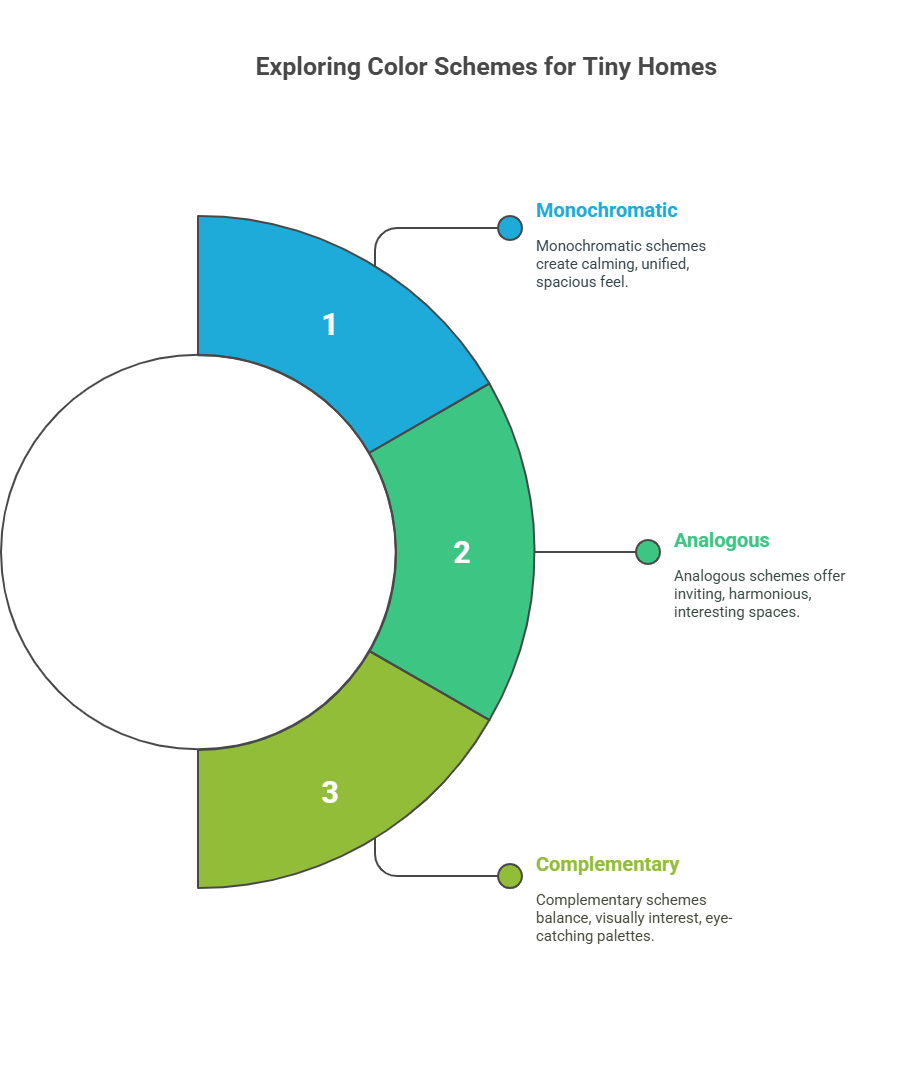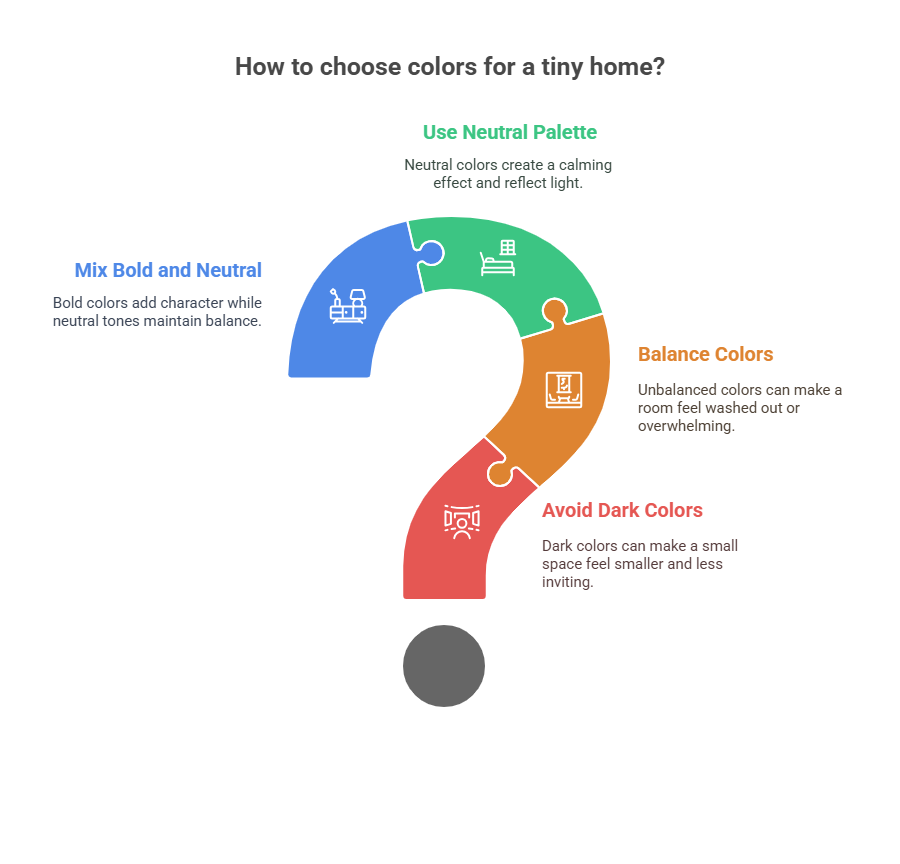Tiny House Color Psychology: The Impact of Color on Small Spaces

Are you ready to paint your tiny home with a brush of magic? Choosing the right colors for your little house is crucial for creating a visually stunning, cozy, and functional living space. At the same time, tiny homes offer unique design opportunities and significant challenges. From cramped quarters to limited natural light, designing a small house requires careful consideration of every detail, including color psychology.
In this article, we’ll show you how to harness the power of color psychology to make your tiny house feel spacious, inviting, and uniquely you. Get ready to discover the secrets of color psychology and turn your teeny home into a work of art!
Color Schemes for Tiny Homes
Color is an important design element that can powerfully impact how we feel within a space. It can visually enhance, define, and transform a room’s atmosphere—especially in small or tight spaces like tiny homes.
When choosing a scheme for a micro home, interior designers often recommend three basic approaches: monochromatic, analogous, and complementary. Before jumping to explaining them, keep in mind that whatever approach you opt for, VistaCreate has got you covered. Its beautiful selection of color palettes will help you choose the best shade for your toasty space.

More to the point, here’s what these approaches mean:
- Monochromatic shades are composed of multiple hues of one single color. This approach creates a calming and unified atmosphere that can make a small space feel larger and more open. Using lighter shades for walls and flooring, combined with darker tones for furniture, window coverings, or accents, can provide depth and dimension in the space without adding too much visual clutter.
- Analogous shades comprise two or more adjacent hues on the color wheel. By choosing hues that are close together on the wheel, this type of scheme helps create an inviting atmosphere while still maintaining a sense of harmony. This approach can work well in a tiny home because it adds interest to the space without being too overwhelming.
- Complementary shades include two hues opposite each other on the color wheel. This method can help create balance and visual interest in a micro home. By choosing complementary shades, such as blue and orange, yellow and purple, or red and green, this scheme will help create an eye-catching palette while maintaining a sense of cohesion.
Overall, using shades effectively in a small space can help create the illusion of space and depth, especially in a restricted space. For example, using light and neutral shades on walls, ceilings, and flooring will make the room appear lighter and airier. Also, judiciously using bright and bold hues can help define separate areas in the space without making it feel too cramped.
Notably, being mindful of color balance is of utmost importance when pondering the color gamma. A room with too much of one single shade can be overwhelming and make the space feel cramped and cluttered.
What would be the way out in this instance? Adding contrasting tones, such as a light floor paired with a dark accent wall or a few vibrant accessories, can help break up the monotony and provide visual interest.
Light shades on the walls or ceilings can also draw the eye up and make the space feel larger. So can strategically-placed mirrors or light fixtures. Adding them in the right places can help reflect light and make even the smallest houses feel more spacious.
Examples of successful color schemes for different styles of tiny homes
Because there are so many styles of micro houses — from rustic to shabby chic — there is no one-size-fits-all approach when choosing hues that will work best within the space. However, some general guidelines can help create an effective color scheme for any small house:
- Consider using cool neutrals such as white, gray, and beige for a modern minimalist look. This minimal palette will help design a calming and inviting atmosphere without being too perplexing.
- Try using shades of orange, yellow, and pink for a brighter and bolder look. This color board can help build an inviting and energizing atmosphere, perfect for small spaces with limited natural light.
- Finally, consider combining warm and cool colors with pops of bright hues for a more eclectic and bohemian look. This technique can help make the space feel more visually exciting and unique, perfect for creating a cozy and inviting atmosphere in their tiny home.
.jpg)
Rookie Color Psychology Mistakes to Avoid
When picking colors for a tiny home, one of the most common mistakes is choosing colors that are too dark or bold for the space. Dark colors can make a small area look even smaller and more bewildering. It can also give the impression of being cramped and dreary, which would only push away your guests. Remember that dark colors absorb more light, which may suit larger areas better.
Another common mistake is choosing unbalanced colors that clash with one another. Some people choose too light colors, making a room seem washed out, uninviting, and depressing. Both extremes of color can have an undesired effect on the overall feel of a teeny home. Therefore, choosing shades that work together to create a cohesive look and feel is paramount.

Avoid Overwhelming a Small Space With Too Much Color
Using a neutral color palette is an excellent way to avoid overwhelming a small space with too much color. Doing so will provide a calming effect to the room while allowing you to add pops of color with furniture and accessories. Try to keep the walls light or white so that the focus remains on the decorative items rather than the walls themselves. Neutral colors will also reflect natural light, making the room brighter and more inviting.
Balance Bold and Neutral Colors in a Tiny Home
Balancing bold and neutral colors in a small home is vital to set up a calming, cohesive atmosphere. Pops of bold colors can liven up the space and give it a unique character without being staggering. On the other hand, pairing these bold colors with neutral tones will create balance and ensure that no single hue takes over the room. Choosing furniture in muted tones is another effective way to add texture without making the space feel overly busy or disarranged.

A Word of Inspiration
As you embark on your tiny house design journey, remember that color is a mighty tool that can transform even the smallest spaces. By using the principles of color psychology, you can create a beautiful, functional, and personalized living environment that reflects your unique style and needs. From calming blues to invigorating yellows, the possibilities are endless. The main point is: don’t be afraid to unleash your inner artist and experiment with color in your tiny home. Embrace the beauty of small living and let color be your guide. The great artist Vincent Van Gogh once said, “Color in a picture is like enthusiasm in life.” So, let your tiny house burst with color and enthusiasm, and make it a place you love to call home.









